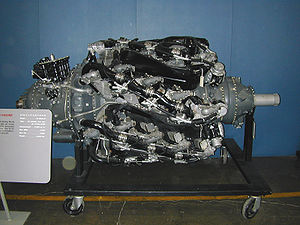Pratt & Whitney R-4360 Wasp Major
R-28 piston aircraft engine family From Wikipedia, the free encyclopedia
R-28 piston aircraft engine family From Wikipedia, the free encyclopedia
The Pratt & Whitney R-4360 Wasp Major is an American 28-cylinder four-row radial piston aircraft engine designed and built during World War II. At 4,362.5 cu in (71.5 L), it is the largest-displacement aviation piston engine to be mass-produced in the United States, and at 4,300 hp (3,200 kW) the most powerful. First run in 1944, it was the last of the Pratt & Whitney Wasp family, and the culmination of its maker's piston engine technology.
| R-4360 Wasp Major | |
|---|---|
 | |
| Pratt & Whitney R-4360 Wasp Major | |
| Type | Four-row Radial engine |
| National origin | United States |
| Manufacturer | Pratt & Whitney |
| First run | 1944 |
| Major applications | Boeing 377 Boeing B-50 Superfortress Boeing C-97 Stratofreighter Convair B-36 Fairchild C-119 Flying Boxcar |
| Number built | 18,697 |
| Developed from | Pratt & Whitney R-2180-A Twin Hornet |
| Developed into | Pratt & Whitney R-2180-E Twin Wasp E |
The war was over before it could power airplanes into combat. It powered many of the last generation of large piston-engined aircraft before turbojets, but was supplanted by equivalent (and superior) powered turboprops (such as the Allison T56).
Its main rival was the twin-row, 18-cylinder, nearly 3,350 cu in (54.9 L) displacement, up to 3,700 hp (2,800 kW) Wright R-3350 Duplex-Cyclone, first run some seven years earlier (May 1937).
The R-4360 was a 28-cylinder four-row air-cooled radial engine. Each row of seven air-cooled cylinders possessed a slight angular offset from the previous, forming a semi-helical arrangement to facilitate effective airflow cooling of the cylinder rows behind them, inspiring the engine's "corncob" nickname.[1] A mechanical supercharger geared at 6.374:1 ratio to engine speed provided forced induction, while the propeller was geared at 0.375:1 so that the tips did not reach inefficient supersonic speeds.
The engine was a technological challenge and the first product from Pratt and Whitney's new plant near Kansas City, Missouri.[2] The four-row configuration had severe thermal problems that decreased reliability, with an intensive maintenance regime involving frequent replacement of cylinders required.[citation needed] Large cooling flaps were required, which decreased aerodynamic efficiency, putting extra demands on engine power when cooling needs were greatest. Owing in large part to the maintenance requirements of the R-4360, all airplanes equipped with it were costly to operate and suffered decreased availability. Its commercial application in the Boeing Stratocruiser was unprofitable without government subsidy.[3] Abandonment of the Stratocruiser was almost immediate when jet aircraft became available, while aircraft with smaller powerplants such as the Lockheed Constellation and Douglas DC-6 remained in service well into the jet era.
Engine displacement was 4,362.5 cu in (71.5 L), hence the model designation. Initial models developed 3,000 hp (2,200 kW), and later models 3,500 hp (2,600 kW). One model that used two large turbochargers in addition to the supercharger delivered 4,300 horsepower (3,200 kW). Engines weighed 3,482–3,870 lb (1,579–1,755 kg), giving a power-to-weight ratio of 1.11 hp/lb (1.82 kW/kg).
Wasp Majors were produced between 1944 and 1955; 18,697 were built.
A derivative engine, the Pratt & Whitney R-2180-E Twin Wasp E, was essentially the R-4360 "cut in half". It had two rows of seven cylinders each, and was used on the postwar Saab 90 Scandia airliner.[4]





Data from White, 1995[21]
Related development
Comparable engines
Related lists
Seamless Wikipedia browsing. On steroids.